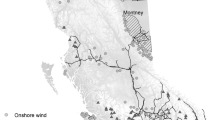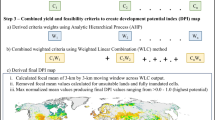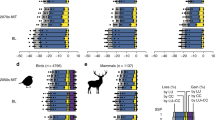Abstract
Fossil fuel dependence can be reduced, in part, by renewable energy expansion. Increasingly, renewable energy siting seeks to avoid significant impacts on biodiversity but rarely considers how species ranges will shift under climate change. Here we undertake a systematic literature review on the topic and overlay future renewable energy siting maps with the ranges of two threatened species under future climate scenarios to highlight this potential conflict.
This is a preview of subscription content, access via your institution
Access options
Access Nature and 54 other Nature Portfolio journals
Get Nature+, our best-value online-access subscription
$29.99 / 30 days
cancel any time
Subscribe to this journal
Receive 12 print issues and online access
$209.00 per year
only $17.42 per issue
Buy this article
- Purchase on Springer Link
- Instant access to full article PDF
Prices may be subject to local taxes which are calculated during checkout


Similar content being viewed by others
Data availability
Datasets are available in the DRYAD repository, accessible at https://doi.org/10.5061/dryad.bnzs7h4j0 (ref. 57). Private access link to download the data files: https://datadryad.org/stash/share/G6ZVrB6TIqhDxNj1_N7IWob-2Opt269EwgnsQKgMMmg.
Code availability
Code for dispersal simulations and species distribution model analysis used in this study are adopted from https://github.com/fmachados/grinnell (ref. 50) and https://github.com/marlonecobos/kuenm (ref. 54).
References
Bouckaert, S. et al. Net Zero by 2050: A Roadmap for the Global Energy Sector (International Energy Agency, 2021).
Schachat, S. R. & Labandeira, C. C. Are insects heading toward their first mass extinction? Distinguishing turnover from crises in their fossil record. Ann. Entomol. Soc. 114, 99–118 (2021).
Horváth, Z., Ptacnik, R., Vad, C. F. & Chase, J. M. Habitat loss over six decades accelerates regional and local biodiversity loss via changing landscape connectance. Ecol. Lett. 22, 1019–1027 (2019).
Weiskopf, S. R. et al. Climate change effects on biodiversity, ecosystems, ecosystem services and natural resource management in the United States. Sci. Total Environ. 733, 137782 (2020).
Lovering, J., Swain, M., Blomqvist, L. & Hernandez, R. R. Land-use intensity of electricity production and tomorrow’s energy landscape. PLoS ONE 17, e0270155 (2022).
Morelli, T. L. et al. Climate-change refugia: biodiversity in the slow lane. Front. Ecol. Environ. 18, 228–234 (2020).
Erfanian, M. B., Sagharyan, M., Memariani, F. & Ejtehadi, H. Predicting range shifts of three endangered endemic plants of the Khorassan-Kopet Dagh floristic province under global change. Sci. Rep. 11, 9159 (2021).
Troia, M. J., McManamay, R. A., Kao, S.-C. & O’Connor, P. W. A heuristic tool to assess regional impacts of renewable energy infrastructure on conservation areas. Biol. Conserv. 263, 109334 (2021).
Grodsky, S. M. & Hernandez, R. R. Reduced ecosystem services of desert plants from ground-mounted solar energy development. Nat. Sustain. 3, 1036–1043 (2020).
Hernandez, R. R. et al. Environmental impacts of utility-scale solar energy. Renew. Sust. Energy Rev. 29, 766–779 (2014).
Walston, L. J. et al. Examining the potential for agricultural benefits from pollinator habitat at solar facilities in the United States. Environ. Sci. Technol. 52, 7566–7576 (2018).
Grodsky, S. M., Campbell, J. W. & Hernandez, R. R. Solar energy development impacts flower-visiting beetles and flies in the Mojave Desert. Biol. Conserv. 263, 109336 (2021).
Sawyer, H. et al. Trade-offs between utility-scale solar development and ungulates on western rangelands. Front. Ecol. Environ. 20, 345–351 (2022).
Conkling, T. J. et al. Vulnerability of avian populations to renewable energy production. R. Soc. Open Sci. 9, 211558 (2022).
Levin, M. O. et al. Solar energy-driven land-cover change could alter landscapes critical to animal movement in the continental United States. Environ. Sci. Technol. 57, 11499–11509 (2023).
Pérez-García, J. M. et al. Priority areas for conservation alone are not a good proxy for predicting the impact of renewable energy expansion. Proc. Natl Acad. Sci. USA 119, e2204505119 (2022).
Hernandez, R. R., Jordaan, S. M., Kaldunski, B. & Kumar, N. Aligning climate change and sustainable development goals with an innovation systems roadmap for renewable power. Front. Sustain. 1, 11 (2020).
Dhunny, A. Z., Allam, Z., Lobine, D. & Lollchund, M. R. Sustainable renewable energy planning and wind farming optimization from a biodiversity perspective. Energy 185, 1282–1297 (2019).
Jager, H. I., Efroymson, R. A. & McManamay, R. A. Renewable energy and biological conservation in a changing world. Biol. Conserv. 263, 109354 (2021).
Mulvaney, D. Identifying the roots of Green Civil War over utility-scale solar energy projects on public lands across the American Southwest. J. Land Use Sci. 12, 493–515 (2017).
Miranda, L. et al. Combining connectivity and species distribution modeling to define conservation and restoration priorities for multiple species: a case study in the eastern Amazon. Biol. Conserv. 257, 109148 (2021).
Xing, L. & Wang, Y. A practical wind farm siting framework integrating ecosystem services—a case study of coastal China. Environ. Impact Assess. Rev. 90, 106636 (2021).
González, A. & Connell, P. Developing a renewable energy planning decision-support tool: stakeholder input guiding strategic decisions. Appl. Energy 312, 118782 (2022).
G7 Climate and Environment: Ministers’ Communiqué, London, 21 May 2021 (UK Government, 2021).
Hernandez, R. R. et al. Techno–ecological synergies of solar energy for global sustainability. Nat. Sustain. 2, 560–568 (2019).
Kruitwagen, L. et al. A global inventory of photovoltaic solar energy generating units. Nature 598, 604–610 (2021).
Dunnett, S., Holland, R. A., Taylor, G. & Eigenbrod, F. Predicted wind and solar energy expansion has minimal overlap with multiple conservation priorities across global regions. Proc. Natl Acad. Sci. USA 119, e2104764119 (2022).
Bernstein, J. M. Climate change, industrial solar, and the globalized local in joshua tree, California. Yearb. Assoc. Pac. Coast Geogr. 78, 80–93 (2016).
Lovich, J. E. & Ennen, J. R. Wildlife conservation and solar energy development in the desert southwest, United States. BioScience 61, 982–992 (2011).
Chock, R. Y. et al. Evaluating potential effects of solar power facilities on wildlife from an animal behavior perspective. Conserv. Sci. Pract. 3, e319 (2021).
Gibson, L., Wilman, E. N. & Laurance, W. F. How green is ‘green’ energy? Trends Ecol. Evol. 32, 922–935 (2017).
Agha, M., Lovich, J. E., Ennen, J. R. & Todd, B. D. Wind, sun, and wildlife: do wind and solar energy development ‘short-Circuit’ conservation in the western United States? Environ. Res. Lett. 15, 075004 (2020).
Solar Impacts on Wildlife and Ecosystems: Request for Information Response Summary (DOE, 2020).
Leskova, O. V., Frakes, R. A. & Markwith, S. H. Impacting habitat connectivity of the endangered Florida panther for the transition to utility-scale solar energy. J. Appl. Ecol. 59, 822–834 (2022).
Martín, B., Perez-Bacalu, C., Onrubia, A., De Lucas, M. & Ferrer, M. Impact of wind farms on soaring bird populations at a migratory bottleneck. Eur. J. Wildl. Res. 64, 33 (2018).
Wiens, J. D. Spatial demographic models to inform conservation planning of golden eagles in renewable energy landscapes. J. Raptor Res. 51, 234–257 (2017).
Pruett, C. L., Patten, M. A. & Wolfe, D. H. Avoidance behavior by prairie grouse: implications for development of wind energy. Conserv. Biol.: J. Soc. Conserv. Biol. 23, 1253–1259 (2009).
Lloyd, J. D. et al. Prairie grouse and wind energy: the state of the science and implications for risk assessment. Wildl. Soc. Bull. 46, e1305 (2022).
Thaxter, C. B. et al. Bird and bat species’ global vulnerability to collision mortality at wind farms revealed through a trait-based assessment. Proc. R. Soc. B: Biol. Sci. 284, 20170829 (2017).
Song, N. et al. Effects of wind farms on the nest distribution of magpie (Pica pica) in agroforestry systems of Chongming Island. China Glob. Ecol. Conserv. 27, e01536 (2021).
Asar, S., Jalalpour, S., Ayoubi, F., Rahmani, M. R. & Rezaeian, M. PRISMA; Preferred Reporting Items for Systematic Reviews and Meta-Analyses. J. Rafsanjan Univ. Med. Sci. 15, 68–80 (2016).
Jeroen, O. pdftools: Text extraction, rendering and converting of pdf documents. R package version 2.3 (2019).
R Core Team. R: A Language and Environment for Statistical Computing (R Foundation for Statistical Computing, 2016).
Berrang-Ford, L. et al. A systematic global stocktake of evidence on human adaptation to climate change. Nat. Clim. Change 11, 989–1000 (2021).
Telenius, A. Biodiversity information goes public: GBIF at your service. Nord. J. Bot. 29, 378–381 (2011).
Fick, S. E. & Hijmans, R. J. WorldClim 2: new 1-Km spatial resolution climate surfaces for global land areas. Int. J. Climatol. 37, 4302–4315 (2017).
Jenkins, J. D., Mayfield, E. N., Larson, E. D., Pacala, S. W. & Greig, C. Mission Net-Zero America: the nation-building path to a prosperous, net-zero emissions economy. Joule 5, 2755–2761 (2021).
Aiello-Lammens, M. E., Boria, R. A., Radosavljevic, A., Vilela, B. & Anderson, R. P. spThin: an R package for spatial thinning of species occurrence records for use in ecological niche models. Ecography 38, 541–545 (2015).
Barve, N. et al. The crucial role of the accessible area in ecological niche modeling and species distribution modeling. Ecol. Model. 222, 1810–1819 (2011).
Machado-Stredel, F., Cobos, M. E. & Peterson, A. T. A simulation-based method for selecting calibration areas for ecological niche models and species distribution models. Front. Biogeogr. 13, e48814 (2021).
Ashraf, U. et al. Ecological niche model comparison under different climate scenarios: a case study of Olea spp. in Asia. Ecosphere 8, e01825 (2017).
Bede-Fazekas, Á. & Somodi, I. The way bioclimatic variables are calculated has impact on potential distribution models. Methods Ecol. Evol. 11, 1559–1570 (2020).
Janžekovič, F. & Novak, T. in Principal Component Analysis—Multidisciplinary Applications (ed. Sanguansat, P.) 127–142 (Intech Open, 2012).
Cobos, M. E., Peterson, A. T., Barve, N. & Osorio-Olvera, L. Kuenm: an R package for detailed development of ecological niche models using Maxent. PeerJ 7, e6281 (2019).
Merow, C., Smith, M. J. & Silander, J. A. Jr A practical guide to MaxEnt for modeling species’ distributions: what it does and why inputs and settings matter. Ecography 36, 1058–1069 (2013).
Peterson, A. T., Papeş, M. & Soberón, J. Rethinking receiver operating characteristic analysis applications in ecological niche modeling. Ecol. Model. 213, 63–72 (2008).
Ashraf, U.,Morelli, T. L., Smith, A.B. & Hernandez, R. H. Aligning renewable energy expansion with climate-driven range shifts [Dataset]. Dryad https://doi.org/10.5061/dryad.bnzs7h4j0 (2024).
Acknowledgements
Funding for U.A., A.B.S. and R.R.H. was provided by the Alfred P. Sloan Foundation’s Energy and Environment Program G-2022-17177. Funding for R.R.H. was also provided by the Agricultural Experiment Station Hatch projects CA-R-A-6689-H and CA-D-LAW-2352-H, the Energy and Efficiency Institute, the Institute of the Environment and the Department of Land, Air & Water Resources at the University of California Davis (UCD). A.B.S. was partially supported by the Alan Graham Fund in Global Change. Any use of trade, firm or product names is for descriptive purposes only and does not imply endorsement by the US Government. We also thank the Global Ecology and Sustainability Lab (UCD) for their valuable comments that improved the manuscript. Icons for the taxonomic groups in Figs. 1 and 2 were retrieved from Noun Project (creator credits: E. Boatman, G. Lonescu, Aleks, J. Meysmans, Corpus Delicti, N. Smith, Vectors Market, M. Livolsi, G. Chicco, B. Agustín Amenábar Larraín and E. Harrison). Photos were retrieved from iNaturalist (creator credits: Chilipossum, Nmoorhatch, Opisska, Douggoldman, Jbartelett79, Johnkrampl, Milliebasden, Codrin_bucur, Ognevit and Euqirneto) and USGS (photographer credit: P. Leitner).
Author information
Authors and Affiliations
Contributions
All authors conceived the idea for this manuscript. U.A. collected the data and conducted the analysis. U.A. and R.R.H. developed the figures and manuscript text draft. R.R.H., T.L.M. and A.B.S. edited the manuscript text and figures.
Corresponding author
Ethics declarations
Competing interests
The authors declare no competing interests.
Peer review
Peer review information
Nature Climate Change thanks Henriette Jager and Andrea Santangeli for their contribution to the peer review of this work.
Additional information
Publisher’s note Springer Nature remains neutral with regard to jurisdictional claims in published maps and institutional affiliations.
Extended data
Extended Data Fig. 1 Analysis of renewable energy siting and biodiversity-related academic articles.
Cumulative number (n = 157) of renewable energy siting- and biodiversity-related academic articles published over time, categorized by tier (a, b, c) and meeting criteria for inclusion in the systematic literature review. Articles that met criteria were allocated to a three-tiered, non-exclusive classification of increasing depth if it documented the: (a) concept of biodiversity, for example, the inclusion of wildlife and other taxa, protected areas for conservation and similar overlapping topics (n = 146, 93%), (b) role of climate change on biodiversity and/or the taxonomic group(s) and/or the species of interest (n = 12, 18.4%) and (c) role of climate change as a driver of range shifts for biodiversity and/or the taxonomic group(s) and/or the species of interest (n = 2, 1.9%).
Extended Data Fig. 2 Frequency of specific keywords within the corpus.
The x-axis represents the key terms used in the search, including the six key terms per category were: (1) Biodiversity - “biodiversity,” “climate change,” “protected area,” “endangered,” “species,” and “wildlife,”; (2) Methods - “multiple criteria decision analysis,” “criteria,” “analytic hierarchy process,” “overlay analysis”, “suitability prediction,” and “maxent;” (3) Renewable Energy Siting - “energy,” “solar,” “wind,” “site,” “plan,” and “planning.” The y-axis shows the mean number of appearances of these keywords in all the articles (error bars represent 95% confidence intervals).
Extended Data Fig. 3 Alignment of renewable energy expansion with climate-driven range shifts workflow.
An example workflow showing major action steps (a) to align renewable energy expansion with climate-driven range shifts. First, research activities (for example, systematic literature review, interviews) are conducted to inform and identify an appropriate list of species that are threatened by climate change and require mitigation action. Diverse research activities (for example, systematic literature review, interviews) that capture the full knowledge system of actors and entities for a specific context and/or geography (for example, wind development in Texas) will reduce the chances of omitting a species of interest. Next, individual or batch species distribution modelling (SDM) is performed for each species and overlaid with spatially explicit models of renewable energy (RE) scenarios. Subsequent analyses are conducted to identify “Optimal RE Siting Pathways” (that is, spatial datasets) and ultimately, a set of decision outcomes that minimize conflicts with species impacted by climate change (“Decision Outcomes”). We provide a more detailed example of “Core Alignment Analyses” in (b).
Supplementary information
Supplementary Information
Supplementary Fig. 1 and Text 1 and 2.
Rights and permissions
Springer Nature or its licensor (e.g. a society or other partner) holds exclusive rights to this article under a publishing agreement with the author(s) or other rightsholder(s); author self-archiving of the accepted manuscript version of this article is solely governed by the terms of such publishing agreement and applicable law.
About this article
Cite this article
Ashraf, U., Morelli, T.L., Smith, A.B. et al. Aligning renewable energy expansion with climate-driven range shifts. Nat. Clim. Chang. 14, 242–246 (2024). https://doi.org/10.1038/s41558-024-01941-3
Received:
Accepted:
Published:
Issue Date:
DOI: https://doi.org/10.1038/s41558-024-01941-3



